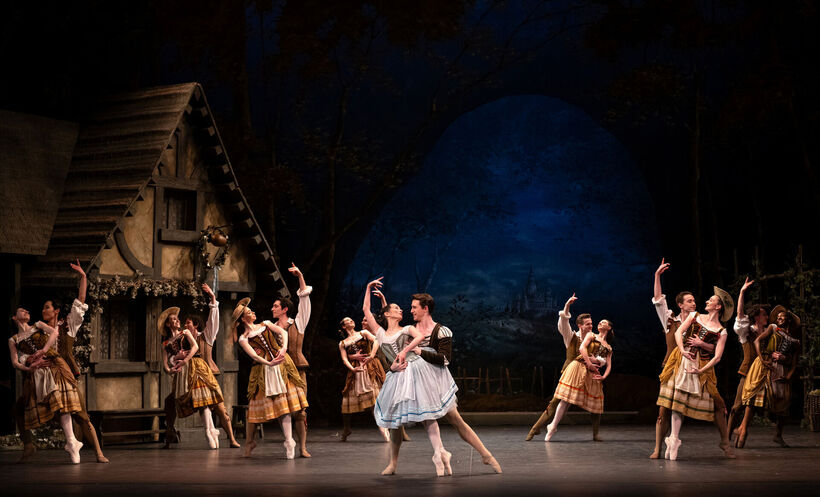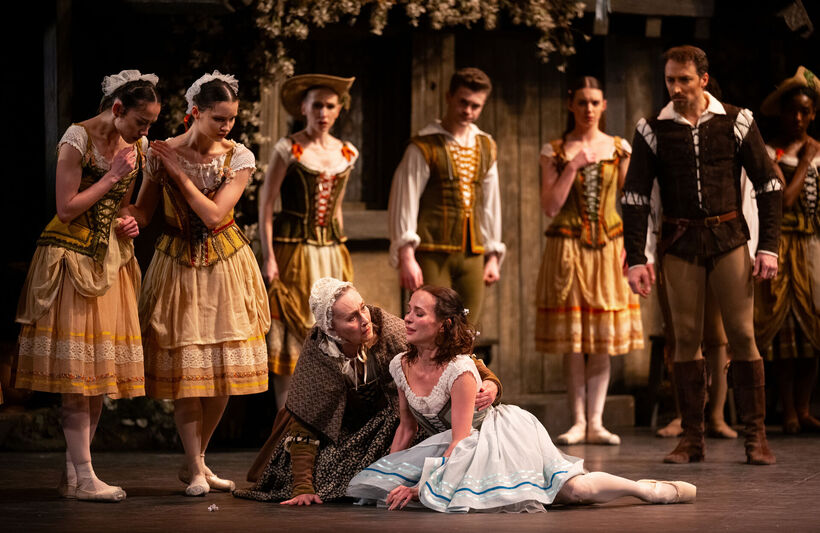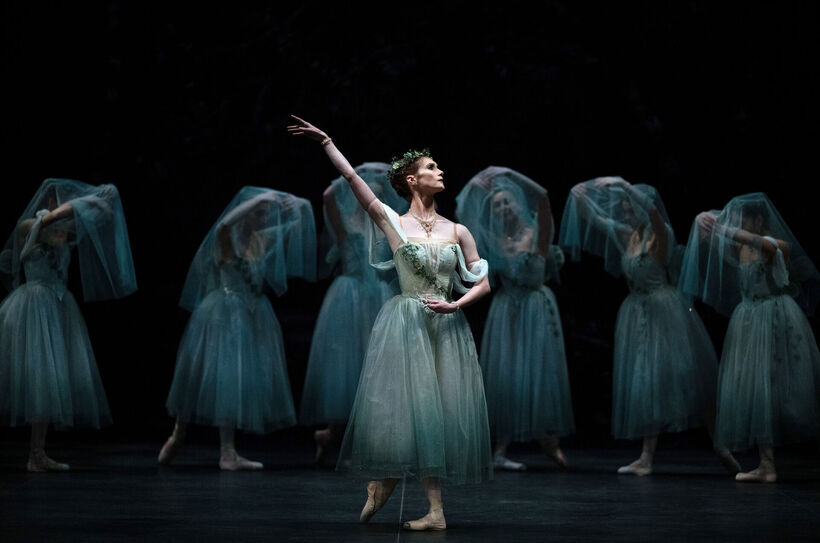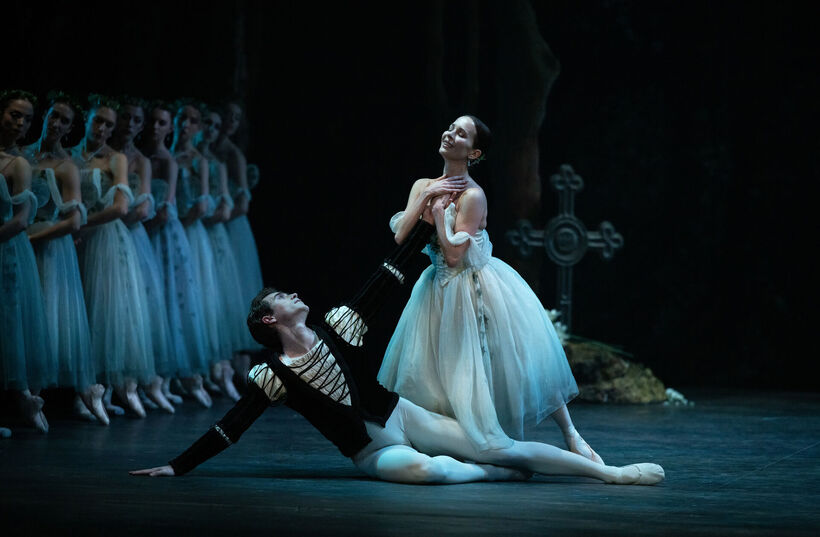Giselle by English National Ballet - rich in all the historical details, yet shallow at times
For this winter season at the London Coliseum, the English National Ballet has delved into its archives and decided to stage the well-loved romantic ballet Giselle in Mary Skeaping's 1971 production. This version was made by the choreographer for ENB's predecessor, London Festival Ballet, and was most likely the first ever attempt to return Giselle to her 1841 roots.
Mary Skeaping herself danced in the Anna Pavlova Company's (1925) and the Camargo Society Nikolai Sergeyev's (1932) productions of Giselle. She then created her own version for the Royal Swedish Ballet for the first time in 1953. Almost twenty years later, she was given the opportunity in London, where she decided to approach Giselle from historical perspectives, reclaiming what the ballet may have lost since its premiere by Jean Coralli and Jules Perrot in the first half of the 19th century.
The first priority for Skeaping, a trained musician, was Adolph Charles Adam's score, which throughout history has been frequently edited, rearranged, and subjected to whatever changes the stager or possibly the lead ballerina deemed appropriate or necessary. The choreographer wanted to avoid this, so she initially worked with a piano extract of the original score (published in print in the 1840s) and then with the full score, the autograph of which she obtained from the archives of the Paris Opera (now available online here). This move is evident in the sheer time span of the production itself, which is running on average a good 15 minutes longer than is usual for so-called traditional versions. Skeaping has restored the entire Pas de vendanges in Act I, a duet intended for Albert and Giselle, then two scenes with the hunters in Act II (Scenes 1 and 6), a complete, uncut variation of Myrtha, and a rarely used fugue from the end of the Scène de wilis, when the fairies try in vain to confuse Albert, who is protected by Giselle's love and the cross on her grave.
It would be a mistake, however, to suggest that Skeaping only quotes the "pure Adam". Since its original premiere, the first act includes the so-called Peasant pas de deux (Pas de deux des jeunes paysans) to the music of F. F. Burgmüller composed for Nathalie Fitzjames. The choreographer also used a much later addition, but one that has become a symbol of Act 1 - a variation of Giselle (pas seul), most probably composed by R. Drigo for the ballerina Elena Cornalba in 1887. Its choreographic form, still more or less preserved today, dates back to 1903, when the title character was danced by Anna Pavlova in Marius Petipa's last staging of the ballet. The finale of this short solo would culminate with a diagonal of simple and multiple pique pirouettes well into the 20th century. Until it began to be replaced, particularly in the Soviet productions, by the technically less difficult and more spacious manège. Mary Skeaping, true to Anna Pavlova's legacy, demanded the diagonal. The performers in this year's revival (staged by Yuri Uchiumi) have for the most part opted for the manège...
Also included is a later variation of Giselle in Act II pas de deux to music by L. Minkus, written for Adèle Grantzow in 1866 or 1867. Moreover, Skeaping also made some cuts (the Peasant pas de deux, for example, has been shortened from the original six to four numbers, and several repetitions from the mad scene have been omitted) and rearrangements from the originally intended progression of musical numbers.

The return to the original libretto by Théophile Gautier and Jules Henri Vernoy de Saint-Georges and the sources providing information about the story in its purely romantic form is also evident. Albeit the approach is not perfectly consistent, and much later adaptations and changes in dramaturgy or in the characterisation and demeanour of individual characters are introduced into the final production.
The ballet begins with the original opening scene of peasants leaving for work in a vineyard. Skeaping even adds a small motif known from the German countryside's harvest season, when each day a large wreath is hung over a chosen house to indicate where the new wine will be sampled that day. Then Hilarion comes and brings pheasants as a gift to Giselle and Berthe (an addition of a much later date). After Hilarion, Albert appears; however, he does not come out of his house, as the original sources stated, but comes running into the village from a small hill in a cloak and with a sword at his waist, a fact that Hilarion, hiding by the first wing sees and gets his first suspicions. This scene, on the other hand, is as depicted in Cyril Beaumont's 1944 publication The Ballet Called Giselle.
The story then unfolds as we are used to from the traditional productions of the ballet. Giselle is a shy, fragile, blushing wallflower who, in a group dance with her friends and Albert, suddenly almost faints (likely to be a 20th century addition again). Albert professes his love for her, the petals of the daisy are torn off, Hilarion confronts the pair, already openly suggesting that Giselle's beloved is not who he appears to be.
In terms of dramaturgy, one of Mary Skeaping's most striking accomplishments is surely the reintroduction of the great mime scene of Giselle's mother Berthe, in which she tells her daughter and all the others about the dead girls, the terrifying phantoms that torture travelers to death at night. Tamara Karsavina, in particular, was an authority on the art of ballet mime for Skeaping. The choreographer also drew on the interpretations of Anna Pavlova and Olga Spessivtseva, particularly in the depiction of Giselle's encounter with Bathilde and the final mad scene. Here, Skeaping favours the scenario of Giselle actually dying of a broken heart rather than a sword wound (which is still a matter of no small argument among historians and artists). Regardless of the cause, the outcome, ie. Giselle's death, should always leave the viewer internally shaken, which was unfortunately not entirely accomplished in the particular performance I have seen, and the whole scene was rather underwhelming.

The Act I closes with a great tragic tableau of the villagers surrounding Bertha with her dead daughter in her arms and Hilarion kneeling miserably at her feet. Albert, as the historical sources suggest, is dragged away, but during Giselle's folly the nobles' entourage (originally present throughout) also disappears. A deviation from the period sources also occurs just after the girl's death, when Hilarion, accused by Albert of Giselle's death, blames the noblemen in disguise. Familiar as this moment is from contemporary productions, it is in direct contrast to the behaviour of the original Hilarion, who went to turn himself in to the Duke during the mad scene, blaming himself for all the ongoing horror, and then subsequently wishing for Albert to actually kill him, as he was convinced he was deserving of death.
In the Act II, Skeaping once again turns her attention back to the original libretto. She brings hunters to the scene, drinking or playing dice in a forest clearing. The approaching Hilarion, however, does not warn the young men of the danger that the nocturnal abandoned forest holds. He is instead falling despairingly towards Giselle's abandoned grave and refusing to leave even as the first fairies begin to appear in the surrounding bushes. Their arrival accompanied by a rather tacky and kitschy effect of bright flashing lights, presumably intended to evoke the atmosphere of a storm, but looking rather like a botched disco.
The whole of Act II is otherwise bathed in greenish light (David Mohr after Charles Bristow), which turns out to be extremely effective when the fairies appear on stage, the light design adding to their sickly, corpse-like appearance and highlighting the similar colour in the hems of their skirts (David Walker). The ghost of Giselle, the only one still snow-white, then stands out all the more.
After Giselle has been transformed into a wili, the hunters from the opening act re-enter the action. This time the wilis, led by Myrtha, join in much more vigorously, as Skeaping masterfully explores the dance motifs from the Queen of the wilis' solo to give them an extra layer and meaning in this new context - they are as tempting, seductive and magnetizing, as they are unforgiving, confusing and dismissive. Originally, the hapless young men were rescued from the woods by an old man; Skeaping dropped him and actually ended her vision of this moment with a question mark - did the men manage to escape, or did the wilis trap them backstage?

Once again, the upcoming chain of events is well-known. Albert finally arrives in the forest (with his dramatic cloak and puget of lilies), Giselle protects him from the wilis lest he meet the same deathly fate as Hilarion, but Myrtha is relentless, forcing Giselle to dance temptingly.
Nevertheless, it all ends with the morning bells. The wilis have to return to their graves, Giselle says her last farewell to the physically, mentally and emotionally exhausted Albert, disappearing forever, and Albert is left alone on the stage with his own sorrow and misery. Here again, Skeaping chooses to break away from the libretto and not close the ballet with the return of the noble entourage with Wilfrid and Bathilde, to whom Albert is to return at Giselle's last wish and to whom he should give the love he holds in his heart.
Most contemporary productions of Giselle end with the lone hero in the centre of the stage. By analogy with this, the last twenty or so majestic bars of the score (in F major), which mark the return to the real world full of daylight and beings made of flesh and blood, are cut out. Skeaping leaves those last bars in place and, thanks to the ingeniousness with which she steadily over the course of Act II decomposes Albert's outer shell, she succeeds in using them to intensify even more poignantly the dreadful despair in which she leaves her hero.
Personally, a production that proclaims a certain return to its roots, or at least an attempt at it, is always extremely appealing to me. Yet, in the case of English National Ballet's show, it has remained just a sensed promise that has failed to come to fruition. Mary Skeaping never claimed to be creating Giselle as she was in 1841, so I cannot fault her for deviating from the original sources. The problem lay rather with this year's staging, which, despite the undeniable qualities of the production as a whole, seemed schematic, shallow and clogged with a number of clichés.
So what's to say that Skeaping has strengthened the mime scenes when none of the performers appear to be convincing in them, which is often caused by the painstaking rhythmization of each gesture and movement. The result then looks forced and stilted, gestures robotic, empty and without any real meaning, rather than a natural and dramatically affecting speech.

Katja Khaniukova, in the title role, was not technically impressive either, lacking confidence, strength and steadiness in her footwork. She was fairly convincing in her acting, at times showing a certain impishness with which she ran towards her beloved. It was her colleague, Aitor Arrieta, who struggled on almost all fronts - the technical inaccuracies in his footwork he tried to save with their high extensions and big leaps, but these in turn were not entirely in harmony with the rather intimate space of the stage. A much more fundamental trouble, however, was his depiction of Albert as a character in whom the form far surpassed the content. He came across as vague, hollow and superficial, as if it were more important for him to focus on the precisely pointed feet and the skillfully billowing cloak than on what his character was really going through as he made his way to the grave of the dearly loved one. To his credit, however, he does manage to build a quite believable transformation of Albert into a broken bundle of nerves and emotions at the very end of the ballet.
Alison McWhinney as Myrtha impressed with her unique phrasing and the dynamic quality of her movements, yet she lacked a bit more charisma, adamancy and power to command the stage at critical moments. The corps of the wilis performed well in Act II, keeping up the intensity, the atmosphere and the synchronisation. From a purely dance point of view, what stood out was the wilis' specific port de bras in 1st and 5th positions, where each arm adopted a slightly different angle at the elbow. This would ideally result in a more sculptural shape filled with greater body volume. Of course, this would require the dancers to actually shape their arms in a more rounded, romantic way, rather than the elongated lines of modern ballet aesthetics.
In fact, the romantic shape was present only twice - in the arrangements of the wilis in Act II, and in the Peasant pas de deux, brilliantly performed by Ivana Bueno and Daniel McCormick, who both showed great technique. Moreover, they were able to interact with each other naturally throughout, which added a liveliness to their otherwise purely virtuoso duet. There was clearly inspiration from period drawings, paintings and lithographs in their duet, which makes it all the more disappointing that no one bothered to bring and utilise this knowledge in any other places.
Nonetheless, there are several aspects of the production that I find extremely pleasing. The Act I Pas de vendanges with Giselle's original flute variation, which, in terms of the character of the music, fits her personality much more aptly than the flamboyantly showy pas seul.
In Act II the fugue, which represents a crucial turning point in the plot and at the same time presents a tremendously attractive musical element. Finally, the last scene, outstanding in its climax, superbly merging the symphonic grandeur of the music with Albert's wretched depression.
Written from the show on 21 January 2024, Coliseum, London.
Giselle
Choreography: Mary Skeaping after Jean Coralli, Jules Perrot and Marius Petipa
Music: Adolphe Charles Adam
Set design and costumes: David Walker
Light design: David Mohr afer Charles Bristowe
Conductor: Gavin Sutherland
The review was funded by the European Union thanks to the Czech Recovery Plan and the Ministry of Culture of the Czech Republic.







